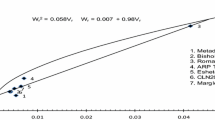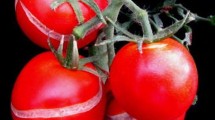Abstract
Development of mutants and their effective utilization to incorporate desirable traits in tomato would be a sound improvement strategy to develop so called ‘smart’ tomato variety of the coming century. Initially we developed three induced mutants from two varieties, ‘Patharkuchi’, a local adapted cultivar and an introduced variety ‘Berika’, and then three crosses (Berika × P Mut-5, Berika × P Mut-11, Patharkuchi × B Mut-1) were made to involve in these two varieties and their respective mutants. Six generations (P1, P2, F1, F2, BC1 and BC2) of three crosses were utilized to study the genetic control of yield and quality traits, and to study the genetic basis of formation of dark green fruit. The nature and magnitude of gene action controlling the inheritance of 27 quantitative traits differed from one cross to another and from one trait to another, mostly conditioned by nonadditive gene action and duplicate epistasis. The prevalence of duplicate epistasis in three crosses for most of the traits revealed that the pace of progress through conventional selection process would be hindered as this kind of epistasis might result in decreased variation in F2 and subsequent generations. Recurrent selection in biparental progenies would be helpful for exploiting this type of nonallelic interaction through generation of high frequency of desirable recombination and concentration of genes having cumulative effects in the population. We also observed complex genetic behaviour of some of the traits revealing significant epistatic components. Inheritance study of ‘dark green fruit’ (dg1) of Berika × P Mut-5 cross revealed a single recessive gene governing the trait and expressed when the mutant gene was in homozygous recessive condition (designated as dg-1/dg-1).
Similar content being viewed by others
References
Akhtar S. and Hazra P. 2013 Nature of gene action for fruit quality characters of tomato (Solanum lycopersicum). Afr. J. Biotech. 12, 2869–2875.
Asmahan A. M. and Al-Twaty N. 2006 Effect of irradiation and sodium azide on some economic traits in tomato. Saudi J. Biol. Sci. 13, 44–49.
AOAC 1990 Official methods of analysis, 15th edition. Association of Official Analytical Chemist, Washington.
Atanossova B., Balacheva E., Kartzeva T. and Hazra P. 2010 Tomato (Solanum lycopersicum L.) A source of carotenoids and anthocyanins in human food. In Proceedings of the Sixth International Congress on Pigments in Food. Budapest, Hungary.
Biswas V. R., Bhatt R. P. and Kumar N. 2011 Gene action in Tomato (Lycopersicon esculentum Mill) under open and protected environments. Veg. Sci. 38, 206–208.
Causse M., Damidaux R. and Rousselle P. 2007 Traditional and enhanced breeding for quality traits in tomato. In Genetic improvement of Solanaceous crops (ed. M. Razdan and A. K. Mattoo), vol 2. Tomato Science Publishers, Enfield.
Comstock R. E., Robinson H. F. and Harvey P. H. 1949 A breeding procedure designed to make maximum use of both general and specific combining ability. Agron. J. 41, 360–367.
Das I. 2019 Characterization and inheritance pattern of the new mutants of tomato. PhD Thesis (Unpublished), Bidhan Chandra Krishi Biswavidyalaya, Mohanpur, Nadia, West Bengal, India.
Das I., Hazra P., Maurya P. K., Longjam M., Banerjee S., Bhattacharjee T. and Chattopadhyay A. 2019 Characterization of induced mutants and their hybrids of tomato (Solanum lycopersicum L.) for growth, yield and fruit quality traits to explore the feasibility in future breeding. Genet. Resour. Crop. Evol. 66, 1421–1441.
Davies B. H. 1976 Carotenoids. In Chemistry and Biochemistry of Plant (ed. T. W. Goodwin), pp. 38–155. Academic Press, London.
Devi E., Sulodhani N. B., Singh A., Bijaya Devi N., Singh G. and Laishram J. M. 2005 Gene action for fruit yield and its components in tomato (Lycopersicon esculentum Mill.). Indian J. Genet. Plant Breed. 65, 221–222.
Dhankar S. K., Dhankar B. S. and Banerjee M. K. 2003 Gene actions for floral traits in tomato at high temperature. Veg. Sci. 30, 42–44.
Dixit G. P., Tanveer H. and Chandra S. 2006 Generation mean analysis for grain yield related traits in field pea (Pisum sativum L.). Indian J. Genet. 66, 147–148.
Dubois M., Gilles K., Hamilton J. K., Rebers P. A. and Smith F. 1951 A colorimetric method for the determination of sugar. Nature 168, 167.
Dutta A. K., Akhtar S., Karak C. and Hazra P. 2013 Gene actions for fruit yield and quality characters of tomato through generation mean analysis. Indian J. Hort. 70, 230–237.
El-Sayed H. H., Abd El-Tawab F. M., El-Souedy A., Sharabash M. T. and Mahmoud A. A. 1994 Effect of gamma irradiation on growth, yield and chemical constituents for three tomato varieties and their crosses. In Second Arab Conference on the Peaceful Uses Energy, 5–9 Nov, pp. 913–923. Cairo, Egypt.
Fisher R. A. 1918 The correlation between relatives on the supposition of Mendelian inheritance. Trans. R. Soc. Edinb. 52, 399–433.
Giovannoni J. J. 2007 Fruit ripening mutants yield insights into ripening control. Curr. Opin. Plant. Biol. 10, 283–289.
Hasanuzzaman H. and Golam F. 2011 Gene actions involved in yield and yield contributing traits of chilli (Capsicum annuum L). Aust. J. Crop. Sci. 5, 1866–1875.
Hayman B. I. and Mather K. 1955 The description of genetic interactions in continuous variation. Biometrics 11, 69–82.
Jáquez-Gutiérrez M., Alejandro A., Pineda B., Angarita P., Ribelles C., García-Sogo B. et al. 2019 Phenotypic and genetic characterization of tomato mutants provides new insights into leaf development and its relationship to agronomic traits. BMC Plant Biol. 19, 141.
Jensen N. F. 1970 A diallel selective mating system for cereal breeding. Crop Sci. 10, 629–635.
Jinks J. L. and Jones R. M. 1958 Estimation of the components of heterosis. Genetics 43, 223–234.
Kearsey M. J. and Pooni H. S. 1996 The genetic analysis of quantitative traits. In Plant genetic group school of biological science. The University of Birmingham, Chapman and Hall, London.
Kendrick R. E., Kerckhoffs L. H. J., Van Tuinen A. and Koorneef M. 1997 Photomorphogenic mutants of tomato. Plant Cell Environ. 20, 746–751.
Kiani G., Nematzadeh G. A., Kazemitabar S. K. and Alishah O. 2007 Combining ability in cotton cultivars for agronomic traits. Int. J. Agric. Biol. 9, 521–522.
Kumar T. P., Tewari R. N. and Pachauri D. C. 1997 Line × tester analysis for processing characters in tomato. Veg. Sci. 24, 34–38.
Levin I., Frankel P., Gilboa N., Tanny S. and Lalazar A. 2003 The tomato dark green mutation is a novel allele of the tomato homolog of DEETIOLATED1 gene. Theor. Appl. Genet. 106, 454–460.
Mather K. 1949 Biometrical genetics. Methuen, London.
Mather K. and Jinks J. L. 1971 Biometrical genetics: the study continuous variations. Chapman and Hall, London.
Mba C., Guimaraes P. and Ghosh K. 2012 Re-orienting crop improvement for the changing climatic conditions of the 21st century. Agric. Food Secur. 1, 1–17.
Menda N., Semel Y., Peled D., Eshed Y. and Zamir D. 2004 In silico screening of a saturated mutation library of tomato. Plant J. 38, 861–872.
Ostergaard L. and Yanofsky M. F. 2004 Establishing gene function by mutagenesis in Arabidopsis thaliana. Plant J. 39, 682–696.
Rajan R. E. B., Kumar C. P. S. and Joshi J. L. 2018 Generation mean analysis for some quality traits in tomato (Lycopersicon esculentum Mill.) Plant Arch. 18, 2083–2086.
Rissanen T. H., Voutilainen S., Nyyssonen K., Salonen R., Kaplan G. A. and Salonen J. T. 2003 Serum lycopene concentrations and carotid atherosclerosis: The Kuopio Ischaemic Heart Disease Risk Factor Study. Am. J. Clin. Nutr. 77, 133–138.
Roopa L., Sadashiva A. T., Reddy K. M., Rao K. P. G. and Prasad B. C. N. 2001 Combining ability studies for long shelf life in tomato. Veg. Sci. 28, 24–26.
Sadasivam S. and Manickam A. 1996 Biochemical methods, 2nd edition. New Age International Publisher, New Delhi.
Sesso H. D., Burin J. E., Zhang S. M., Norkus E. P. and Gaziano J. M. 2005 Dietary and plasma lycopene and the risk of breast cancer. Cancer Epidemiol. Biomarkers Prev. 14, 1074–1081.
Sharmila V., Krishnamoorthy G. S. and Gunasekaran M. 2007 Generation mean analysis for quantitative traits in sesame (Sesamum indicum L.) crosses. Genet. Mol. Biol. 30, 1–5.
Sikder S., Biswas P., Hazra P., Chattopadhyay A., Badigannavar A. M. and D’Souza S. F. 2013 Induction of mutation in tomato (Solanum lycopersiccon L.) by gamma irradiation, EMS and their combinations. Indian J. Genet. Plant B. 73, 392–399.
Singh R. K. and Chaudhary B. D. 1985 Biometrical methods in quantitative genetic analysis. Kalyani, Ludhiana.
Somraj B., Reddy R. V. S. K., Ravinder Reddy K., Saidaiah P. and Thirupathi Reddy M. 2017 Generation mean analysis for quality and physiological traits of tomato (Solanum lycopersicum L.) under high temperature conditions. J. Pharmacogn. Phytochem. 6, 198–200.
Somraj B., Reddy R. V. S. K., Ravinder Reddy K., Saidaiah P. and Thirupathi Reddy M. 2018 Generation mean analysis of yield components and yield in tomato (Solanum lycopersicum L.) under high temperature conditions. J. Pharmacogn. Phytochem. 7, 1704–1708.
Stacewicz-Sapuntzakis M. and Bowen P. E. 2005 Role of lycopene and tomato products in prostate health. Biochem. Biophys. Acta 40, 202–205.
Stommel J. R. 2007 Genetic enhancement of tomato fruit nutritive value. In Genetic improvement of Solanaceous crops (ed. M. Razdan), vol. 2. Tomato Science Publishers, Enfield.
Van der Hoeven R., Ronning C., Giovannoni J., Martin G. and Tanksley S. 2002 Deductions about the number, organization, and evolution of genes in the tomato genome based on analysis of a large expressed sequence tag collection and selective genomic sequencing. Plant Cell 14, 1441–1456.
Wu K., Erdman J. W., Schwartz S. J., Platz E. A., Leitzmann M., Clinton S. K. et al. 2004 Plasma and dietary carotenoids, and the risk of prostate cancer: a nested case-control study. Cancer Epidemiol. Biomarkers Prev. 13, 260–269.
Zdravkovic J., Pavlovic N., Girek Z., Brdar-Jokanovic M., Savic D., Zdravkovic M. and Cvikic D. 2011 Generation mean analysis of yield components and yield in tomato (Lycopersicon esculentum Mill.). Pak. J. Bot. 43, 1575–1580.
Acknowledgements
The first author is thankful to the Science for Equity, Empowerment and Development Division, Department of Science and Technology, Govt. of India for providing financial assistance in carrying out this research.
Author information
Authors and Affiliations
Corresponding author
Additional information
Corresponding editor: Manoj Prasad
Rights and permissions
About this article
Cite this article
Das, I., Hazra, P., Longjam, M. et al. Genetic control of reproductive and fruit quality traits in crosses involving cultivars and induced mutants of tomato (Solanum lycopersicum L.). J Genet 99, 56 (2020). https://doi.org/10.1007/s12041-020-01209-7
Received:
Revised:
Accepted:
Published:
DOI: https://doi.org/10.1007/s12041-020-01209-7




